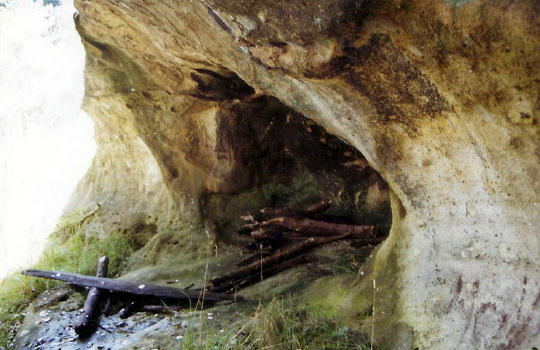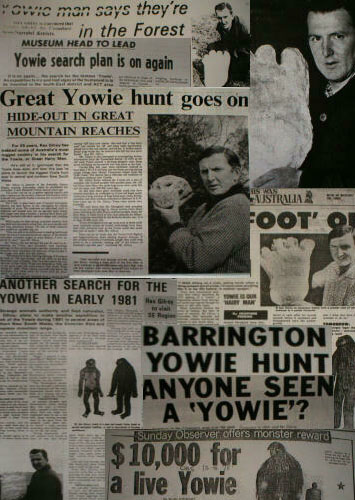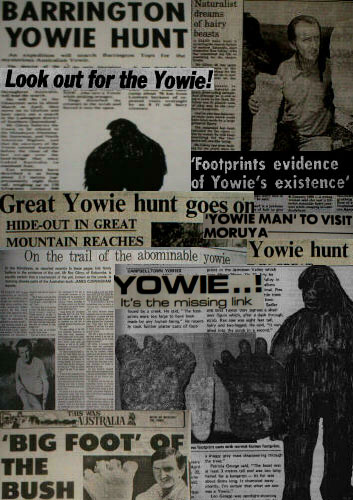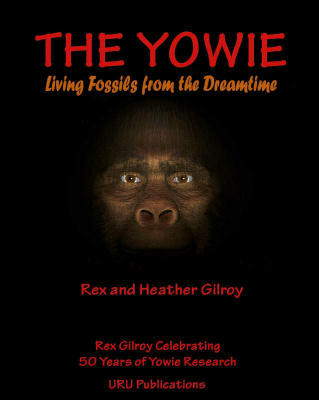Dreamtime Tales of the Hairy People
This article is composed of extracts from the 2007 book:
“The Yowie Mystery - Living Fossils From The Dreamtime".Copyright (c) 2007 Rex Gilroy, Uru Publications.

We have seen how our early European settlers were made aware of the ‘hairy man’ in all his incarnations by the Aborigines they befriended. Let us now study their ancient traditions of these mysterious hominids of Dreamtime Australia.
Photo Left: This rock shelter, situated outside the Katoomba business area, is claimed by local Aborigines to have been the home of a “Gubri Man and Hoori Woman” in the ‘Dreamtime’. These fearsome Homo erectus-type hominids made fire here, and ate the bodies of Aborigines they had killed, cutting them up with jagged sharp stone knives and choppers.
Bands of these fearsome 5-6ft tall males roamed the Katoomba scrub and swamps of old in search of food, and the Aborigines kept well clear of them at all times. Photo copyright © Rex Gilroy 2006.
The myths and legends of the early tribespeople concerning the ‘hairy man’ were recorded over a wide area of the Australian mainland as well as Tasmania by early anthropologists and other researchers. These once again as with the early European sighting claims and close encounters, fall into three categories, namely beings of average human height, pygmy and giant-size.
The best known ‘hairy man’ was undoubtedly that which existed throughout the eastern Australian mountain ranges. They were known by many names depending upon the numerous dialects spoken by the Aborigines, but all translated to the same meaning – “hairy man”. This same being exists elsewhere in Australia under many more names, all meaning the same thing. These Yowies were described as standing, in the case of males, at up to 2m, even 2.6m in height at times.
They were often strong, muscular-looking beings, with long head hair with hairy chests, but otherwise they would have looked no more hairy than average modern European males today. The females were smaller, at around 1.5m in height, with even less hair than the males but for their long head hair. They were lighter built, with long pendulous breasts in the case of older females who had had children. The heads of these beings were distinct from those of the Aborigines, being long and narrow in shape [ie doliocephalic], with low foreheads and thick, projecting brow ridges. If, as seems likely, that this ancient description of the Yowie is correct [and Aboriginal knowledge of past species of Ice-Age times has been proved to be quite accurate], then the general appearance of the primitive beings recalls Homo erectus, as will be further demonstrated.
According to the Aborigines, the sounds emitted by these hairy people varied from grunts to a crude speech, and they signalled one another with loud cries, or else among hunters when in sight of their prey, with silent gestures. That Homo erectus was capable of speech is a subject to which we shall return.These ‘hairy people’ were not called so because they were covered in hair, as I have already stated, but because they wore marsupial hide cloaks crudely sewn together, the hair of these being responsible for the supposed ‘hairy’ appearance of the Yowies. Our Aboriginal people are adamant that the ‘hairy people’ made fire by friction, using the same methods as the Aborigines.
They manufactured crude stone, wood and bone tools; killing animals for food as well as feeding upon nuts, berries, roots and other vegetable food. They were hunter-gatherers like the Aborigines, constantly on the move from one location to the next following the food chain. In the short time that they would occupy a rock shelter they were ‘territorial’ in the sense that they might chase away others of their kind. However, and the Aborigines were adamant about this point, the ‘hairy people’ never erected ‘territorial markers’, such as placing broken tree limbs or stakes against tree trunks etc to ‘mark out’ their ‘territory’!
The Yowies roamed the forests and open plains in the old days, either as single individuals in search of food, or in pairs of males, a male and female or in family groups of adult males and females with children. Sometimes two or three families might band together but the tribal concept as such did not exist. Aboriginal accounts often refer to a single individual, ie the hairy Man; the Hairy Woman; the Doolagharl; the Pankalanka etc when in reality they were referring to an entire population. Photograph right: Aboriginal Girl wearing a Kangaroo hide Garment. Photographer Unknown. I will credit anyone who owns this photograph.
Thus, when the tribespeople of western Victoria in the old days told early European settlers about the Ngaut-Ngaut, The blood-sucking hairy man who was said to kill and eat any Aborigines and whites who strayed into his domain, they were speaking of a race, a population, and Ngaut-Ngaut beings were said to roam the countryside in search of their prey. While the name ‘Yowie’ was commonly applied by the tribespeople to these primitive hominids, we can see they were known by many other names as well.
On the northern side of the Grose Valley, deep in the Blue Mountains extending northwards through the vast reaches of the Wollongambie Wilderness, the Darkinjung tribespeople feared a malevolent hairy manbeast called by them Ghindaring. His body hair was said to be reddish, and he was associated with volcanoes [still active hereabouts a few thousand years ago]. These beings wandered the mountainsides, and the Aborigines kept clear of them, lest they become the next cannibal meal of one of these monsters.
If any hairy hominids of Aboriginal Dreamtime tradition [and remember, the ‘hairy’ title always referred to the animal hide garments worn by them] ever evoked the image of Homo erectus, it was the ‘Gubri Man’ and the ‘Hoori woman’. Much folklore still surrounds one of their campsites at Frog Hollow, Katoomba although this ugly pair roamed the mountains and valleys of the entire region and this included the Burragorang/Jenolan and Kanangra Boyd Wildernesses also. And of course, once more, we are dealing with an actual population rather than one male and female.
They were the most feared beings of the Blue Mountains tribes, as they were cannibalistic, feeding upon Aborigines as if they were a favourite food, so that tribespeople kept well clear of these hominids. They were very ‘hairy’ and brutish-looking people, who when not eating Aborigines, hunted animals and also lived upon roots, berries and other ‘bush tucker’. They could often be seen [by tribespeople at a distance hiding in shrubbery] at their Frog Hollow rock shelter, cutting up their prey with crude, jagged stones, uttering strange guttural sounds to one another. If they realised they were being watched they would emit loud shouts and make threatening gestures, which would be enough to chase off their intruders.
Their appearance certainly fits the image of Homo erectus. What is even more interesting is that local Aborigines believe the Gubri Man and Hoori Woman’s descendants still wander the Blue Mountains wilds today! Throughout the central and north-west of New South Wales, what appears to have been the same beings were known as the ‘Winembu’. There are places where Aborigines will not tread even today, particularly on the Gwydir River at Moree and along the Namoi River around Walgett, because these fearsome hominids are still believed to inhabit those places.
Much larger hominids than these average-size ‘hairy’ people were known to the north-western New South Wales tribes. These hominids were no more than 2-2.5m tall, but they were very powerful, muscular people [at least in the case of the males], and the Aborigines avoided them for fear of their lives. They inhabited the hilly country north of Tibooburra up to the Queensland border country. On into Queensland we find yet many more names for the “hairy people”, both normal to giant-size height. The cave-dwelling ‘Bundja bundja ganija’ beings, preserved in the folklore of the Wankumara tribespeople, lived near Coopers Creek and over a wide area of the rocky country of the border ranges into north-western New South Wales.
They were of average human height, made fire and used crude stone and wooden implements, and were of course cannibalistic, eating Aborigines at every opportunity. They certainly fit the Homo erectus appearance. The ‘little hairy men’ of the Far North Queensland jungles have already been described in the previous chapter, yet they shared those wilds with the ‘Turramulli’, fearsome giant beings said to be around 3-4m in height. They are reminiscent of the ‘Pankalanka people’ of the Gulf Country to the ‘Red Centre’, whose average height was about the same as theirs. The Pankalanka are said to use big wooden or stone clubs and make fire, with which they roast any Aborigines they catch [they are supposed to eat white people too if they come across them!].
Some giant beings of the Aboriginal Dreamtime were more ape-like in physical appearance than human. One such primate-looking being was the Jimbra, which the old tribes of the dry, central region of Western Australia believed, wandered about either singularly or in groups, in search of human prey. The Jimbra’s general physical appearance was that of a 4m or so tall, powerfully-built, muscular giant, with huge feet and hands and a great head sunk into the shoulders, big, projecting eyebrow ridges and a big, wide mouth which, whenever one of these monsters snarled, revealed large teeth.
The Pankalanka wandered into the Northern Territory and South Australia at times it is said, which led them into the domains of other, similar “Giants from the Dreamtime”: monstrous beings such as the Tjangara, the ‘Monster-Man of the Nullarbor’, a being who, with his massive stone club and other ‘megatools’ fits the image of a race of giant Homo erectus. The literature on these beings is voluminous, and we recommend the reader to our book “Giant from the Dreamtime – The Yowie in Myth and Reality” [URU Publications 2001] for a great deal more on this subject.
“The Yowie Mystery - Living Fossils From The Dreamtime".
“The Yowie Mystery - Living Fossils From The Dreamtime". Special Dedication. The Authors dedicate this book to the late Charles Melbourne Ward F.Z.S.; F.R.Z.S. known to his great many friends simply as ‘Mel’. Together with his wife Halley, he operated a natural history museum in the grounds of the Hydro Majestic Hotel at Medlow Bath for many years and also another established at Echo Point, Katoomba. It was ‘Mel’ who first taught me how to collect, record and study natural history specimens, beginning when I was aged 11 years old on holidays with my parents at Katoomba in 1954. Thereafter, every school holidays spent in Katoomba began with a visit to ‘Mel’ at his Medlow Bath Museum to inform him how my fledgling natural science studies were progressing!
As a result and after my parents moved from our Lansvale [western Sydney] home to Katoomba, the Gilroys and Wards became close friends. There was hardly a week which did not see me peddling my pushbike from our North Katoomba home up the Great Western Highway to see ‘Mel’ at his museum for more instruction. Mel Ward possessed a wide knowledge of the culture of the Australian Aborigines and that of the former local Blue Mountains tribes in particular.
He was also a firm believer in the “Hairy Man” and supported my researches in this regard. At my 21st birthday party, held at the Homesdale Function Centre, at Katoomba on Saturday night 8th November 1964, I well recall how my old friend, in front of a large gathering, congratulated me on my researches and the large natural science collection that I was forming and then said: “You’ve done a fantastic job Rex, BUT IT’S ABOUT TIME THAT YOU STARTED MAKING SOME BLOODY MONEY OUT OF IT” in a loud voice that brought the house down!
That following week, together with my father Mr W.F. [Bill] Gilroy, I began a search of local venues, which soon resulted in the acquisition of the lease from the Blue Mountains City Council of the Mt York Tea Rooms, outside Mt Victoria, the rest they as “is history”. Two years late, on October 6th 1966, Mel Ward was dead, having passed away in his sleep. He once said to my father that I was “the Mel Ward of Tomorrow” and I am certain that Mel would be pleased to know that I have indeed followed in his footsteps.
Mel led an adventurous life. The son of Hugh J. Ward, a famous Shakespearean actor of the early 20th century, Mel was encouraged to go on the stage by his father but Mel developed a passion for the natural sciences and his wealthy parents helped him become established. In his lifetime of achievement, Mel became recognised as a world authority on Crustaceans and an anthropologist. He was made a Fellow of the Royal Zoological Society of New South Wales and was pleased when I too became a member of the Society in 1963. He encouraged me, not long before his death, to take on the Presidency of the Society’s Entomological section, where I served for three years from 1966 to 1969.
That he achieved so many things in the course of his lifetime researches is remarkable, because like this author, he was an amateur with not one university degree to his name! I am certain that my old friend would be delighted at the fact that, together with heather, I am now writing and publishing book on the subjects he loved and on the Yowie in particular. He taught me never to blindly follow the textbook and dare to question dogmas and not be told what to think! I have certainly followed his advice. Knowing Mel Ward as I did I know he would wholeheartedly approve of the scientific approach of this book, therefore “Mel”
This Book is for You!
Rex Gilroy - Australian Yowie Research Centre, Katoomba, NSW.
Monday 25th June 2007I also present sensible advice to any future would-be Yowie investigators. The reader will also be awed at the great many discoveries my wife Heather and I have made in all our years together in the field. I feel privileged to be the founder of Yowie research and to have encouraged other, sensible researchers to follow my example. The search for surviving relict hominids in remote, hidden regions of the world, has been called the “last great search”, and it is both a fascinating and exciting one. Rex Gilroy may be contacted at the Australalian Yowie Research Centre, PO Box 202, Katoomba. NSW 2780. Ph 02 4782 3441 or email New Email Address as of June 2009 randhgilroy44@bigpond.com on or visit our website : http://www.mysteriousaustralia.com/ or http://www.australianyowieresearchcentre.com/ or http://www.rexgilroy.com/
Newspaper Articles on Rex Gilroy's Lifetime Search for the Australian Yowie
Newspaper Articles on Rex Gilroy's Lifetime Search for the Australian Yowie
Aboriginal/Koori Names for the Australian Yowie
To present the Yowie mystery in its proper context, relict hominid evidence from south-east Asia, New Guinea, other west Pacific Islands and New Zealand is revealed, demonstrating how the ancestors of these ‘manimals’ once spread out across the earth via land-bridges that formerly joined Australia/New Guinea/New Zealand with what is now island south-east Asia to the Asian mainland.
“Hairy man” was a name given by the Aborigines to any non-Aboriginal race with which they shared this continent, but the term centred primarily upon at least three basic forms. These forms were either the height of an average human being, an enormous man-like and also ape-like form. All were known by different names Australia-wide, but all meant either “hairy man” or “great hairy man”.





